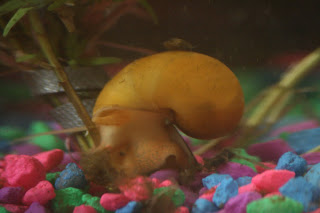This is MapleShade. She/he/it is a Gold Mystery Snail.
We decided to do a science project in January and I'm ashamed to say that I didn't do as much research as I should have before we started. Had I done my research, I would have known that this particular type of snail is a hermaphrodite (they don't need to have sex to breed, they have both sets of organs).
Those little packets that look like tiny wads of chewing gum are actually the egg sacs. The eggs will stay where they are, allowing the snails to grow for 2 - 4 weeks. They don't necessarily hatch at the same time as the water temperature plays a role in how quickly the eggs develop. In a small, controlled environment like this, there isn't much difference in the water temperature, but in a large aquarium or in nature, it can have a huge effect.
We currently have four egg sacs, each containing up to 15 eggs, though most of those will be devoured by the snail or snails that hatch first. Only one or two eggs from each sac will survive long enough to hatch. Once they do hatch, the babies will eat the softest vegetation, steering away from the healthier, more robust parts of the plant. After about a week, they can eat anything the adults can.
We started with two Mystery Snails, a gold and a dark brown. Another tidbit I wish I'd known before I bought them is that this type of snail typically lives for 2 - 10 years, sometimes longer if the water is kept around 80 degrees. Albert, the dark brown snail, died within a month, but not before the egg sacs he was covered with hatched.
These are both from the first egg group and the larger one near the top is about 1/4 inch long. We haven't named the little ones because there are so many of them (15 at last count) and we don't really have a good way of telling them apart.
That darker shell is what's left of Albert. When his babies hatched, they could often be seen crawling in or on his shell. I assume that is a protective instinct since their shells take a bit of time to harden and they would be searching for safety from predators.
We bought a single plant in January when we set up our little snail habitat and just last week we had to replace it. The snails eat the plant or will also eat small pieces of spinach, kale or other leafy greens, as well as cooked carrots, cucumbers and, in extreme circumstances, other snails.
Our snails live in a one gallon glass jar and they seem to do fine, although I don't think it can hold too many more before we'll have to start disposing of the egg sacs before they hatch.
The cover of our jar is a piece of mesh bag (that I bought oranges in), cut to size and tied with a shoelace to keep it in place. Snails are prone to leaving if they're uncomfortable and I didn't want to wake up to find snails on the living room floor one day. As it is, I think the mesh is pretty unnecessary at this point. MapleShade doesn't try to escape and the holes in the mesh are too big to keep the small snails in. But it keeps us from accidentally dropping things into the jar, if nothing else.
The kids love to watch the snails and it can be quite entertaining to watch them crawl all the way to the top of the jar and then simply let go and float down to the bottom again. All in all, I wish I'd done the research before we bought them, but I'm glad we did.





No comments:
Post a Comment